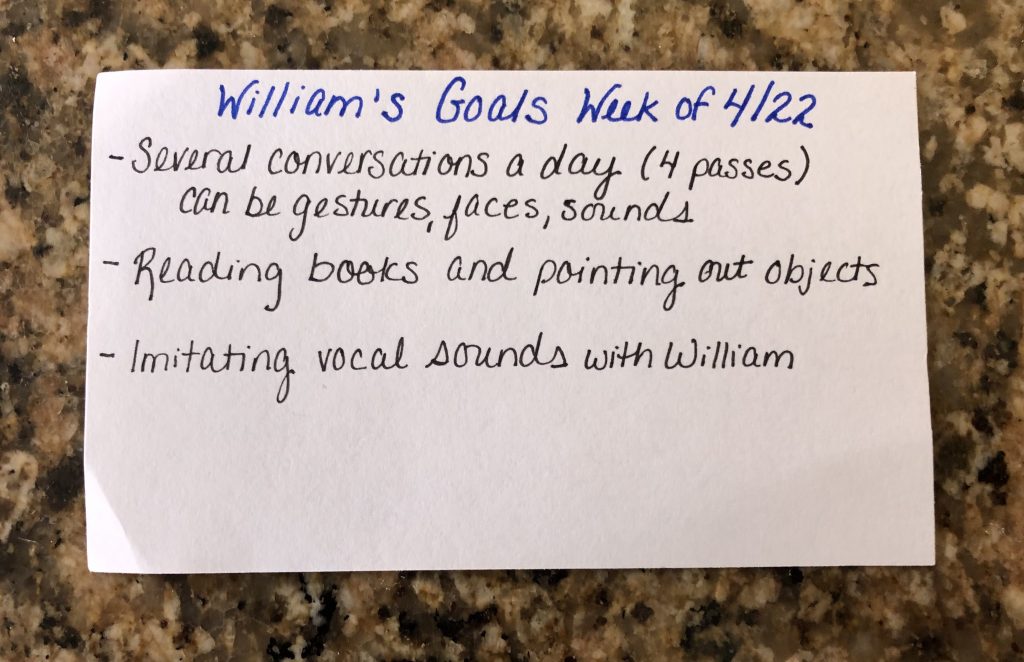
The two months leading up to the widespread stay-at-home advisories were a blur. I was working two jobs, with increased hours at both. It had been a hectic and chaotic start of the spring semester at my job supporting administrators at a local university, and after two years of stepping back from my freelance sports writing, it had ramped back up and I was writing for four publications regularly. Sadly, when I was home, my head wasn’t there at all.
The closure of my sons’ daycare in March made it all grind to a halt. Two days into staying home with them, it hit me. My youngest, then 17 months old, was no longer talking.
He hadn’t spoken much ever, occasionally saying, “Dada,” “Mama,” and “Marv” (the name of one of our cats, whom I named after former Buffalo Bills head coach Marv Levy — yes, I know that’s a bit odd). But he wasn’t even saying any of that anymore. He wasn’t babbling. He was mostly silent. He cried when he wanted something, but he mostly just sat and played silently.
One night, after I put both my kids to bed, I asked my husband if he had noticed our toddler’s silence as well. He said yes, but it seemed to coincide with his two recent double ear infections, the latter of which he was still on antibiotics for. He was sure it would come back.
However, I couldn’t shake the thought that something was wrong. I reread a few developmental milestone checklists I had last looked at with my firstborn, and I realized my youngest was late on some things and had missed others. It wasn’t just speech — there were some small motor development steps as well.
Over that weekend, someone posted about Early Intervention services in one of the Facebook mom groups I follow. The poster mentioned that their toddler’s Early Intervention appointments were being moved online. It spurred me to start researching local Early Intervention services. At 10 p.m., I emailed the director of the nearest location explaining my worries about my son and asking if they were taking new clients.
By 7 a.m. the next day, I had an email back. Yes, services were still being offered, just via online sessions instead of at-home visits. And yes, I could enroll my son, and I wouldn’t even need a doctor’s referral. Two hours later I received a phone call from a coordinator who wanted to see if I had any questions. I was impressed at how quick it all was.
Within days, my son and I were sitting in front of my computer, Zoom conferencing with an intake coordinator, occupational therapist, and speech therapist. We did several developmental screenings, discussed his medical history, and set up insurance approvals and payments within just two Zoom appointments.
By week three of our stay-at-home, my youngest and I started twice-weekly appointments with specialists over Zoom. My toddler didn’t get it at first and didn’t want to pay attention to the screen. But by the fourth week, it started to click. My son loved his speech therapist’s friendly cat, who liked to interrupt our appointments to headbutt her. He started to smile and giggle at his occupational therapist’s welcome song.
And not only did my toddler start to engage in his online visits, he started making progress. “Mama” and “Dada” came back. One of our early evaluations diagnosed him with low muscle tone, so we started working on balance and core strength by setting up pillow obstacle courses. Not only is it fun for all of us, it has helped his walking become much steadier. Overall, my toddler seems so much happier and spunkier.
But there are some drawbacks to starting our early intervention journey in this way. First, our approval for services is short-term, and we may have to redo portions of some of the lengthier evaluations once at-home visits can begin again. Also, having to juggle the 60- and 75-minute appointments when also trying to work full-time from home and taking care of two kids can be stressful. The work our occupational therapist can do is somewhat limited to whatever she can see via the video camera and what she can instruct me to try.
That said, I’m grateful I get to be so hands-on as we begin receiving services. If this wasn’t a stay-at-home, our therapists would be visiting my son at daycare, not at home. While I would be receiving regular reports, I would be somewhat disconnected from the process. My being present for our appointments allows me to be more deliberate in the follow-up and learn the background of each exercise or activity. I create goal flashcards after each appointment, and it creates a visual reminder for me to work the exercises for each into our playtime. I get to work one on one with him on these goals, and he gets to work on them without the sometimes-chaotic environment daycare can bring.
So far, Early Intervention has been a giant help for my son, and I’m looking forward to witnessing his further growth with our therapists’ assistance. These dedicated professionals have successfully pivoted their work within our current stay-at-home reality to the benefit of so many families.













